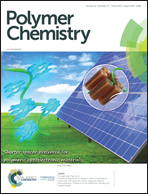Disassembly and tumor-targeting drug delivery of reduction-responsive degradable block copolymer nanoassemblies
Abstract
Smart nanoassemblies based on well-defined block copolymers undergoing chemical transition through stimuli-responsive degradation (SRD) have been extensively explored as effective candidates for intracellular drug delivery. They are designed to be stable in physiological conditions after being administered through intravenous injection; however, in response to triggers found in cellular environments (cellular stimuli), SRD-exhibiting nanoassemblies are destabilized (or disintegrated), leading to the enhanced release of encapsulated drugs. A particular interest is reduction-responsive disulfide chemistry because of the presence of cellular glutathione in biological systems. This review summarizes recent strategies that have been explored to synthesize novel disulfide-containing reductively-degradable block copolymers and their nanoassemblies. The strategies can be classified by the number, position, and location of the disulfide linkages in block copolymers and their nanoassemblies for single and dual-location responses. With focus on the design, synthesis, and reductive degradation, this review discusses the important aspects in the development of reduction-degradable nanoassemblies toward effective tumor-targeting intracellular drug delivery.



 Please wait while we load your content...
Please wait while we load your content...